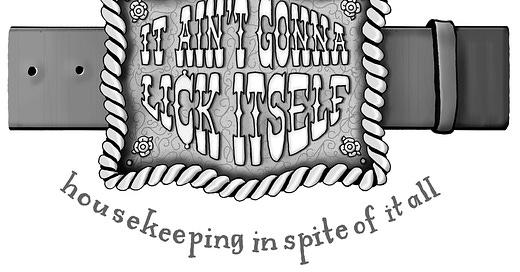This post is a chapter of the book It Ain’t Gonna Lick Itself: Housekeeping In Spite Of It All, by Hanne Blank Boyd.
Click here for the full table of contents.
Once upon a time there was a guy named Abraham Maslow. He was a world-famous psychologist. Now he is a dead psychologist, having dropped dead of a heart attack whilst jogging. (Entropy takes its cut, as I believe I may have mentioned. Even if you jog.)
In 1943 Maslow published a paper called “A Theory of Human Motivation” in the journal Psychological Review. With it, he changed the way a lot of people thought about themselves and the world. In that paper, Maslow listed a tiered, hierarchical set of human needs and proposed that they helped to explain the intrinsic human motivations that get people to do all the various things they do.
Remarkably, he really did mean all the things. One of the reasons Maslow’s list was and remains such a powerful tool to think with is that it offers an answer to the “why?” of literally everything human beings do, from “why do we eat?” to “why do we style our hair?” to “why do we pray?”
Many people are familiar with this list in the shape of a pyramid, with “physiological needs” at the bottom and “transcendence” at the top and six other categories of needs in between, listed in order of importance with the most important at the bottom. It looks like this:
Maslow did not ever put his list into pyramid form. Oher people did that later, in a fantastic example of how human beings add order to things in order to make them work better. In this case, a specific visual structure was superimposed on Maslow’s list, instantly making the order seem intuitive. It all rests on a physiological foundation. Then, as the needs become less essential to biological survival, they occupy less space and have a less structurally important role.
The needs at the top aren’t particularly load-bearing. This is one of the reasons the pyramid works so well as a visual metaphor: you can chop off the top of a pyramid and the structure stands just fine. There are lots of flat-topped pyramids in the world, as a matter of fact, Chichén Itzá being a particularly grand and famous one.
But if there’s no base, there’s no pyramid at all. Something has to hold it all up. That was Maslow’s point: human beings have lots of needs and some are more fundamental than others, like the irreduceable needs of the physical body. Food. Water. Air. Warmth. Shelter from the elements. You know: all the things the spaces in which we live are created to provide.
Keep reading with a 7-day free trial
Subscribe to Reasons Not to Quit to keep reading this post and get 7 days of free access to the full post archives.






